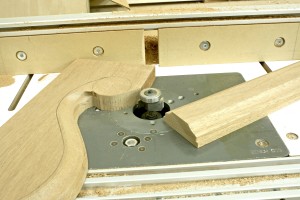Shaping Profiles Using a Router
Routers produce accurate & predictable results on straight, angled, or circular edges & on inside/outside curves. Routers can do so many things: molding, grooving & rabbeting planes and scratch stocks. The Triton MOF001 & TRA001 routers are perfect for routing shaping profiles. Offered in two sizes, the MOF001 is more compact with a 2 HP motor making it more than capable to handle any job, but light enough for hand-routing. The Triton TRA001 features 3-1/4 HP and has a high range of RPMS: 8,000 – 21,000.
Triton routers are quick to set up, and leave a smooth, professional finish thanks to the variable speed motors. Different materials & techniques require different routing speeds. Although running at top speed gives the best finish for general wood & plastic laminate work, it also has a greater tendency to burn the wood than slower speeds.
Types of Router Bits Needed
For general edge routing the most common shapes you will see are: flush trim, chamfer, roundover & rabbet. Using carbide-tipped router bits versus high speed steel pays off in the long run. High speed steel dulls very quickly and if overheated can lose its temper and become to soft to use. Tungsten carbide tips cut easily through hard materials and stay sharper much longer,especially when used on particle board & plastic laminate. The carbide bits will eventually start to dull, but you can have them professionally sharpened. Carbide Processors offers sharpening services for router bits and saw blades.
Always choose the shortest router bit you can. The longer the cutting edge, the more potentially damaging vibration & deflection the tool suffers. Using the largest diameter shank your router will accommodate will help for similar issues. Use caution when using very large diameter bits for panel raising or shaping thick materials that require slower speeds. At high speeds these bits can cause dangerous kickback, and are subject to severe stress that leads to breakage.
If a piece of a bit breaks off, it can be thrown out with great force. To reduce strain and get a better finish with larger bits, remove as much waste material as possible beforehand by chamfering, using a smaller diameter bit or take multiple shallow passes.
Routing Technique
Most often you will get better results if you don’t try to remove all the waste in one pass. It is better to take several shallow cuts instead, lowering the bit a little each time and finishing up with a very light cut to assure a smooth surface.
*Do not change the cutting depth by adjusting the bit shank in the collet. Adjust the router base to set the cutting depth (the Triton plunge route is makes this a lot easier!)
Feed direction is very important when routing. Always feed the router in a direction opposite the way the bit is rotating. Keep a firm grip on the router to maintain control at all times.
As versatile as the portable router is, it can be even more helpful by mounting it upside down in a router table. It then becomes a stationary machine, a small shaper, that can be used with a variety of fences, hold-downs & stops. The large diameter bits previously mentioned are unsafe to use freehand, but secured in a router table they can greatly extend your range of joinery & shaping choices.
Leave a Reply




